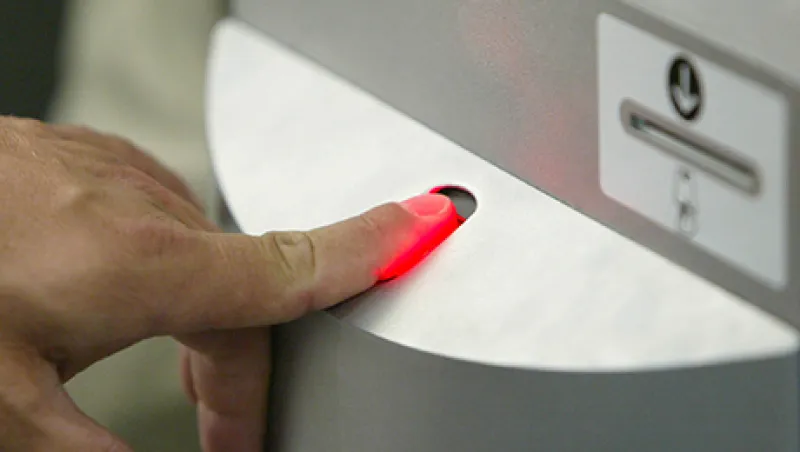The first Men in Black film (1997) earned $589 million. It made the idea of aliens living among us part of the collective imagination of a generation and combined the American detective genre with the inherently grand swagger of sci-fi. It also cemented Will Smith’s status as a mainstream movie star. But before Smith’s character — the tough-talking, charming police officer James Edwards — can become a government agent, he has to undergo a long initiation that ends with the erasure of his civilian identity. The training sequence is stuffed with surprises, but in retrospect it also contains one of the film’s quaintest moments, from the perspective of current technology: Smith places his hands on a large silver sphere that — to his surprise — burns his fingerprints off. As if that were all you need to do to make someone biologically untraceable.
Fingerprinting belongs to a family of technologies called biometrics: the science of measuring our biological traits. Each of us is born with a unique body, inside and out. In the age of biometrics, fingerprints are far from the only identifying trace a secret agent could leave. Identification by DNA sample (including the sequencing of a subject’s full genome), iris patterns, the electrical signatures of the heart and brain, and even personal smell has changed the way we think about identity and about human individuality. Investment opportunities in this field are fascinating and varied and span the globe, crystallizing around new and crucial developments in the ways that identity is managed, in business and in government, at home and in international politics.
DNA is by far the most successful means of identifying anyone, though its commercial applications are limited because of expense and for reasons of privacy as well as a suite of regulations related to selling products that claim to diagnose health problems. (Recall the scandal that erupted over the relationship between genomics service 23andme and the FDA, which ordered the company to stop selling its DNA sequencing kits in 2013.) New Orleans–based InnoGenomics uses its array of technologies to help diagnose cancer and to establish positive IDs based on forensic DNA samples too incomplete for earlier models.
Ilía Sistemas SL in Spain partnered with the Universidad Politécnica de Madrid to develop a method for the unique identification of humans based on odor. Scent spectrometry has already been employed to identify certain pests in crops; it can also apparently be used to generate a psychological profile, conjuring up shades of the dystopian. So, too, might experiments at the University of California, Irvine, with biometric authentication and identification based on the signature of the electricity in someone’s nervous system: The goal is to make transactions relying on PINs and passwords more secure, by checking a PIN against the electrical activity transmitted by the fingers of the person typing it. While neither technology presents an easy opportunity for investors as of yet, start-ups may very soon begin emerging.
Iris scans (and retinal scans, which read the blood vessels at the back of the eye) have the advantage of being fast. It is also extremely difficult to modify any part of the eye without damaging it — which isn’t true of fingerprints, per the Men in Black example. EyeLock sells a commercial iris scanner called myris as well as two other scanners for business and government use. Its HBOX is a large overhead video device that can identify up to 50 individuals a minute — and in motion. In late September, EyeLock received the first patent for the manufacture of iris scanners to be used at commercial airports. Obvious applications are for border control and national security. For ordinary travelers these may speed up lines.
What might the world look like with iris scanning in place? Since 2007 the Indian government’s Unique Identification Authority has been enrolling citizens for what is called Aadhaar, a rough equivalent of a U.S. Social Security number, with one key difference: Aadhaar numbers are issued only after the provision of biometric information including an iris scan, fingerprints and a facial scan.
This program may change the shape of Indian infrastructure, since more than half a billion Indians possess no ID of any kind and the government struggles to direct social security benefits past corruption to their appropriate beneficiaries. The Aadhaar system sits atop what is becoming the largest biometric database in the world, more information about more people than anywhere else: Its biometrics sector may grow to $2 billion by 2018.
The U.S. uses the Automated Biometric Identification System, or IDENT. Once, your signature was the unique mark that signified both your identity and your word, literally and metaphorically. Now the 2014 film Kingsman shows a crazed Samuel L. Jackson attempting to destroy the world with a broadcast weapon unlocked by a double biometric sensor that reads his pulse and requires both of his hands at once — and someday very soon you may pass all the same information to the ATM without thinking about it. Disney World uses fingerprint scanners so that tickets can’t be passed from person to person. Nowadays, a man without fingerprints wouldn’t even be allowed inside — sorry, Agent Smith.






